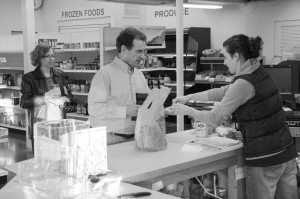The Allegany Harvest Cooperative Market (Co-op) is struggling financially, and without significant improvement in their sales by December, it will be forced to close.
 Dr. Sunshine Sullivan, co-op board president, said that one cause for the current situation is the fact that half the members did not renew their membership for another year. Part of the reason for this is that many members have moved out of the area and no longer find it practical to shop at the co-op. But, another reason may be that the co-op does not sell all that they need to keep afloat. Rather than being able to go to the co-op and get all they need, customers often must make a trip there and then to another store, often the Shop-n-Save in Fillmore, to finish buying all their necessary groceries.
Dr. Sunshine Sullivan, co-op board president, said that one cause for the current situation is the fact that half the members did not renew their membership for another year. Part of the reason for this is that many members have moved out of the area and no longer find it practical to shop at the co-op. But, another reason may be that the co-op does not sell all that they need to keep afloat. Rather than being able to go to the co-op and get all they need, customers often must make a trip there and then to another store, often the Shop-n-Save in Fillmore, to finish buying all their necessary groceries.
Vice-president of the board Peter Meilaender stated that residents in the area were not as interested in organic items in the area as the board members initially thought that they would be. Therefore the number of families included in calculations for weekly organic sales were much lower, resulting in profits that were overall lower than expected.
Another problem the co-op faces is accommodating the diversity in what customers want and need, according to Meilaender. It has proven more difficult than expected to meet the diverse demands of the people in the area. Though some may shop at the co-op just for the fresh produce, others come for the organic food or for various other reasons. Keeping up with these demands continues to be a struggle for the co-op.
Further down the list of difficulties the co-op has faced include issues with its building and with store maintenance. “We’ve had repeated problems with the floor, problems with cooling systems, [and] two changes in management,” Meilaender explained. “All these things cause at least short and sometimes longer problem periods where we have to shut the store temporarily, or sell out (or throw out) stock at a loss, or re-design systems.” In addition to cutting into its sales during closed days, these problems have cost the co-op money that it cannot afford to spend.
The board members’ ultimate goal, in order to remain in business in the long term, is to earn $4000 more in sales per month. For now, the board members have a target amount of $150 to $200 more monthly. This would be enough to hire a part-time manager and alleviate much of the current volunteer duties from the board members.
One of the ideas that board members have implemented to increase income is the practice of allowing co-op members to order and pre-pay for items. That way, members can purchase specific items not on shelves and purchase them in bulk.
Sullivan encourages student participation, saying that “students can help by shopping there more and putting suggestions in the suggestion box.” Although non-members cannot make pre-paid orders, they can advise board members as to which items of which they might like to see more in the co-op. All in all, what the co-op needs more than anything is patronage.
Closure of the co-op, if necessary, will affect many. The store still has loans from the bank and from about forty members who will not be repaid if it closes. The vendors who currently sell to the co-op will also have to find other venues through which to sell their goods. In addition, the customers in the Houghton area who depend on the co-op for much of their shopping will be forced to go elsewhere. Rebecca Rowley stated on Alleganyharvest.coop that, “ The [Allegany Harvest Cooperative Market] will provide a way for me to both get the quality of food I desire and support the local economy without having to track down individual farmers – a win/win situation!” Closing the co-op will force customers like her to either travel greater distances to acquire the same goods or settle for unwanted food.
Although those who enjoy the benefits of the co-op are many, the store will most likely have to close if it does not gain business soon. The members do not wish for this to happen; however, a realistic view of the co-op’s current state is required. Until forced to close, it is their wish to keep the store running.

